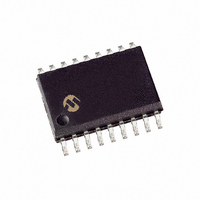PIC16C84-04/SO Microchip Technology, PIC16C84-04/SO Datasheet - Page 17

PIC16C84-04/SO
Manufacturer Part Number
PIC16C84-04/SO
Description
MICRO CTRL 1KX14 EPR EEPR 18SOIC
Manufacturer
Microchip Technology
Series
PIC® 16Cr
Datasheet
1.PIC16C84-04P.pdf
(108 pages)
Specifications of PIC16C84-04/SO
Core Processor
PIC
Core Size
8-Bit
Speed
4MHz
Peripherals
POR, WDT
Number Of I /o
13
Program Memory Size
1.75KB (1K x 14)
Program Memory Type
EEPROM
Eeprom Size
64 x 8
Ram Size
36 x 8
Voltage - Supply (vcc/vdd)
4 V ~ 6 V
Oscillator Type
External
Operating Temperature
0°C ~ 70°C
Package / Case
18-SOIC (7.5mm Width)
Lead Free Status / RoHS Status
Request inventory verification / Request inventory verification
Data Converters
-
Connectivity
-
Available stocks
Company
Part Number
Manufacturer
Quantity
Price
Part Number:
PIC16C84-04/SO
Manufacturer:
MICROCHIP/微芯
Quantity:
20 000
4.3
The Program Counter (PC) is 13-bits wide. The low
byte is the PCL register, which is a readable and
writable register. The high byte of the PC (PC<12:8>) is
not directly readable nor writable and comes from the
PCLATH register. The PCLATH (PC latch high) register
is a holding register for PC<12:8>. The contents of
PCLATH are transferred to the upper byte of the
program counter when the PC is loaded with a new
value. This occurs during a CALL, GOTO or a write to
PCL. The high bits of PC are loaded from PCLATH as
shown in Figure 4-6.
FIGURE 4-6:
4.3.1
A computed GOTO is accomplished by adding an offset
to the program counter (ADDWF
table read using a computed GOTO method, care
should be exercised if the table location crosses a PCL
memory boundary (each 256 word block). Refer to the
application note “Implementing a Table Read” (AN556).
4.3.2
The PIC16C84 has 1K of program memory. The CALL
and GOTO instructions have an 11-bit address range.
This 11-bit address range allows a branch within a 2K
the
(PCLATH<4:3>) are programmed to the desired
program memory page. If a CALL instruction (or
interrupt) is executed, the entire 13-bit PC is “pushed”
onto the stack (see next section). Therefore, manipula-
tion of the PCLATH<4:3> is not required for the return
program memory page size. For future PIC16CXX
program memory expansion, there must be another
two bits to specify the program memory page. These
paging bits come from the PCLATH<4:3> bits
(Figure 4-6). When doing a CALL or a GOTO instruction,
instructions (which “pops” the PC from the stack).
1997 Microchip Technology Inc.
PC
PC
user
12
12 11 10
2
Program Counter: PCL and PCLATH
COMPUTED GOTO
PROGRAM MEMORY PAGING
5
PCH
PCLATH<4:3>
PCH
must
PCLATH
PCLATH<4:0>
8 7
8 7
LOADING OF PC IN
DIFFERENT SITUATIONS
PCLATH
ensure
PCL
PCL
that
11
8
PCL). When doing a
0
0
these
INST with PCL
ALU result
GOTO, CALL
Opcode <10:0>
as dest
page
bits
4.4
The PIC16C84 has an 8 deep x 13-bit wide hardware
stack (Figure 4-1). The stack space is not part of either
program or data space and the stack pointer is not
readable or writable.
The entire 13-bit PC is “pushed” onto the stack when a
CALL instruction is executed or an interrupt is acknowl-
edged. The stack is “popped” in the event of a RETURN,
RETLW or a RETFIE instruction execution. PCLATH is
not affected by a push or a pop operation.
The stack operates as a circular buffer. That is, after the
stack has been pushed eight times, the ninth push over-
writes the value that was stored from the first push. The
tenth push overwrites the second push (and so on).
If the stack is effectively popped nine times, the PC
value is the same as the value from the first pop.
Note:
Note:
Note:
Stack
The PIC16C84 ignores the PCLATH<4:3>
bits, which are used for program memory
pages 1, 2 and 3 (0800h - 1FFFh). The use
of PCLATH<4:3> as general purpose R/W
bits is not recommended since this may
affect upward compatibility with future
products.
There are no instruction mnemonics called
push or pop. These are actions that occur
from the execution of the CALL, RETURN,
RETLW, and RETFIE instructions, or the
vectoring to an interrupt address.
There are no status bits to indicate stack
overflow or stack underflow conditions.
PIC16C84
DS30445C-page 17

















